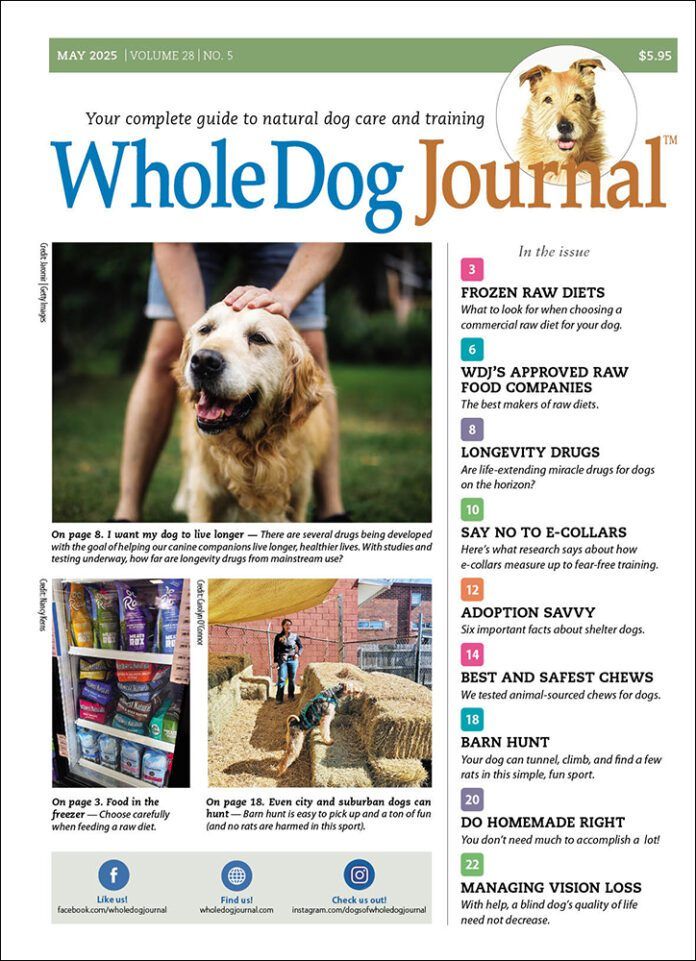- Frozen Raw Diets
- WDJ’s Approved Raw Food Companies
- Longevity Drugs
- Say No to E-collars
- Adoption Savvy
- Best and Safest Chews
- Barn Hunt
- Do Homemade Right
- Managing Vision Loss
Download The Full May 2025 Issue PDF
The 5 Best Dog Treat Pouches for Training, Hiking, and Dog Walks
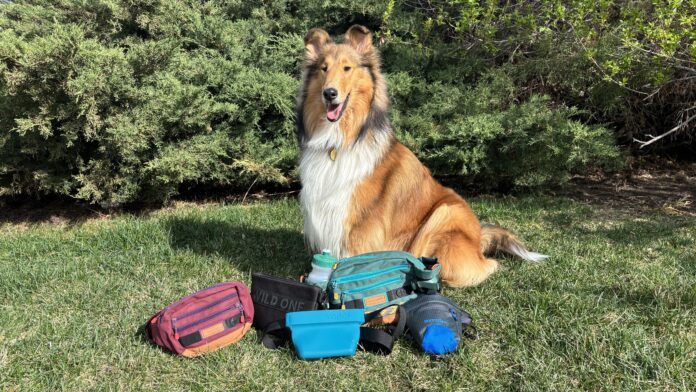
Whether you have a nervous pup who needs lots of counter-conditioning or you just want to keep your dog’s recall sharp, carrying treats with you in a dog treat pouch is vital. You never know when a training opportunity will arise, and one of the best ways to positively reinforce your dog is with a tasty snack.
We tested five popular options and came up with the best dog treat pouches and bags for hiking, training, and more. Read on for how we tested and our top picks:
Traits We Want in a Dog Treat Pouch
- Ease of use: A dog treat pouch should be easy to wear, easy to fill, easy to open and close, and easy to clean. We prioritized the pouches that stayed on, were comfortable to wear, and felt hassle-free to use.
- Size range: We prioritized treat pouches that offered solid capacity options and could fit a good amount of food. We also looked for options that would comfortably fit a wide variety of people.
- Spill-proof design: Treat pouches that constantly spill are more annoying than useful. Whether you’re bending down to reward a small dog or running alongside your pup, your treats should stay firmly inside your treat pouch. We prioritized options with reliable closures that didn’t spill.
- Extra features: Extra features like poop bag dispensers, water bottle compartments, or room for your phone and keys are big pluses.
The 5 Best Dog Treat Pouches
| Rating | Product and Maker | Price | Capacity | Notes |
|---|---|---|---|---|
    | Wilderdog Utility Pack | $36 | 2.5 Liters | This moderately sized pack is big enough to house plenty of treats, a roll of poop bags, and all your everyday carry items like your phone, keys, and wallet. |
    | Wilderdog Mega Hip Pack | $48 | 3 Liters | This pack is gigantic in a good way. Three separate compartments, two water bottle holders, and a built-in poop bag dispenser make it the best pick for hiking with your dog. |
   | Voila Mini Ultimate Treat Pouch | $49 | 0.35 liters | A silicone treat pouch is best for raw-fed dogs or folks who use fresh treats that get messy. The Voila Mini requires a bit of setup and care but is easy to clean and feels durable. |
   | Ruffwear Treat Trader Dog Treat Pouch | $39.95 | Not listed | If you don’t need all the bells and whistles of a fancy treat pouch, the Ruffwear Treat Trader is functional and simple. You can’t fit your phone and keys in this option, but it’s durable and easy to open and close with one hand. |
   | Wild One Treat Pouch | $44 | Not listed | For the style savants out there, the Wild One Treat Pouch looks more like a fashion accessory than a piece of dog gear. It’s easy to open and close and comes in muted colors, but doesn’t always close all the way. |
Best Dog Treat Pouch: Wilderdog Utility Pack
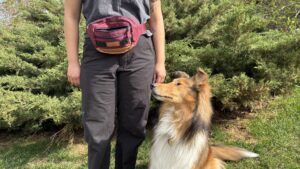
The Wilderdog Utility Pack has been my go-to dog treat bag for over four years. It held up to years of tough, nearly daily use and just a few months ago, I accidentally broke one of the zippers. My partner almost immediately bought me another one because he knew I loved it so much.
This dog treat pouch is the perfect size to fit all the necessities comfortably without feeling overly bulky. It has three zippered compartments: large, medium, and small. I usually use the biggest compartment to hold my phone, my keys, a leash, and a collapsible bowl, the medium compartment to hold treats, and the small compartment to hold poop bags.
The smallest compartment has a built-in poop bag dispenser. You can also put treats of different values in the different compartments, which is helpful for training sessions.
The waist strap on this pouch extends up to 48 inches and Wilderdog offers an additional strap extender for an extra 24 inches, so it’s extremely size-inclusive. I also love that any excess strap is held by the built-in strap keeper, so it doesn’t hang loose. The buckle is large and sturdy, but easy to clip and unclip.
This pouch can also be washed on the gentle cycle of your washing machine for easy cleanup — just remember to hang dry it.
At $36 and with a multiple-year lifetime, the Wilderdog Utility Pack is easily the best dog treat pouch I’ve tested.
Best Dog Treat Pouch for Hiking: Wilderdog Mega Hip Pack
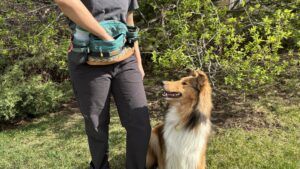
If you regularly go on long outings with your dog, or you need enough treats and gear for multiple dogs, the Wilderdog Mega Hip Pack is your best option. It’s hilariously large, but still functional and works best for hiking.
The two water bottle compartments on the side fit a regular plastic water bottle or smaller dog water bottles. Wilderdog also makes an eco-friendly plastic bottle that fits in these compartments. This pack is perfect for folks who live in a hot climate and need to bring water along on dog walks, but also like going hands-free.
Aside from the two side water bottle compartments, the Mega Hip Pack is essentially a larger version of the Utility Pack. It features three zippered compartments and a poop bag dispenser, and is large enough to carry your phone, a collapsible dog bowl, a roll of poop bags, an extra leash, and tons of treats, along with two water bottles.
At $48, this dog treat bag is on the pricier side, but it will basically replace a tote bag or backpack while still giving you easy access to your gear and keeping you hands-free while adventuring with your dog.
Best Silicone Dog Treat Pouch: Voila Mini Ultimate Treat Pouch
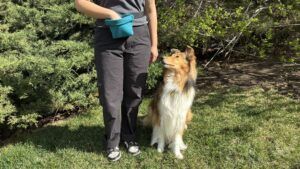
Folks who feed their dog raw, refrigerated, or messy treats should go for the Voila Mini Ultimate Treat Pouch. This silicone treat pouch has a spring-assisted closure that keeps treats fresh when you’re not using it but is still easy to open and close.
This pouch requires a little bit of setup when taking it out of the box, as you have to attach the belt, keeper, and buckle to the pouch. It also has specific care requirements, like occasional lubrication of the spring-assisted joints. This pouch requires more care and is a bit heavier than traditional fabric treat pouches, but it also feels extremely well-made.
The Voila Mini is dishwasher safe, but the brand recommends handwashing to keep the pouch in the best condition possible. It’s made of food-grade silicone and won’t absorb any smells or germs like fabric treat pouches, which is especially important if you use fresh treats like cheese, chicken, and deli meats or raw/freeze-dried raw snacks for your dog.
The mini version holds 12 ounces of treats and is lightweight with a thin waist strap. The brand also offers larger versions if you have a big dog or plan on feeding entire meals from the pouch.
Best Dog Training Treat Pouch: Ruffwear Treat Trader Dog Treat Pouch
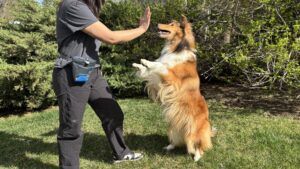
If you just need a simple treat pouch for training sessions, the Ruffwear Treat Trader is a solid option. It has a water-resistant outer shell that works great in inclement weather and the inner liner is waterproof, so messy treats won’t leak through the layers of fabric.
This pouch has both a waist strap and a clip to attach to a belt or pants, but the waist strap is much more secure. The magnetic closure is pretty good, but small crumbs will occasionally spill out if you bend down a lot while wearing it. The pull tab on the magnetic closure, however, is super handy for opening the pouch with one hand.
The Treat Trader is described as ergonomic, and the curvature of the top of the bag can be adjusted so it best suits your body.
This pouch won’t fit your keys, phone, and other everyday carry items, but it’s a good simple option if all you need to take with you are treats and maybe a few poop bags.
Most Stylish Dog Treat Pouch: Wild One Treat Pouch
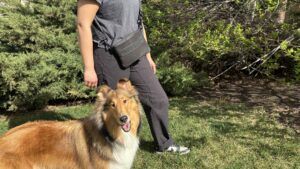
For those who want a dog treat pouch that doesn’t look like a dog treat pouch, the Wild One Treat Pouch is a good option. This pouch looks more like a sleek shoulder bag than dog gear and holds a solid amount of treats. It can be worn as either a fanny pack or a cross-body bag, and comes in muted, minimal colorways.
This pouch can easily be opened with one hand and the metal frame closure keeps it mostly closed when not in use. With that being said, this pouch doesn’t close 100% of the way and can’t be sealed shut, so if you regularly bend down or run, you may spill treats. This option is best for folks who stick to calm training walks as opposed to active jogs or play sessions with their dog.
The Deadly Foxtail: What to Know as a Dog Owner

You can find them from Portland to Poughkeepsie, from Boston to Blackwater…in fact, you’ll find them almost every state in the nation. Despite their sweet-sounding name, they’re one of the most noxious and detested plants in North America: the foxtail. They can also be deadly to your dog.
First, let’s get some nomenclature out of the way. Foxtails are a weedy grass in the grass family of Poaceae, which includes everything from wild rice to bluegrass to sugarcane. Except for knotroot foxtail—the oldest cultivated cereal in the Americas that dates to almost 9000 BCE—none of the foxtail grasses are native to North America. They likely originated in Africa and entered North America with the prehistoric migrations of the ancestors of Native Americans across the Bering Straits land bridge.
What is a Foxtail?
Foxtails are clusters of tall, slender weeds with long, drooping leaf blades; their stems are topped by bristly, spike-like panicles that have a soft, bushy appearance that vaguely resemble a fox’s tail—hence, the name “foxtail.” Plants germinate in the spring, with flowering beginning in mid-summer as days begin to shorten. The first seeds mature about two weeks after the panicle flowers; then, as the plant begins to dry out in the summer months, the seed heads become brittle and fall off.
What Makes Foxtails So Dangerous to Dogs?
While cases of foxtail infiltration occur throughout the year in warm climates, these weeds are especially dangerous during summer and early fall, when they have dried out and hardened. All foxtail spikes (awns) have a hardened tip and retrose (backward-pointing) barbs which disconnect easily and cling to animal fur—or in the case of humans, to socks, mesh-topped shoes, and any clothing with loose weaves or textures. In animals, the barbs, which point in only one direction, cling to the fur, and with every movement, burrow deeper into the coat. For wild mammals, their fur is usually short enough that the foxtail awns will eventually fall out before doing damage.
The same cannot be said of our dogs.
Foxtail awns easily penetrate soft tissue, traveling throughout the body for days or even months before clinical signs appear. Often, an abscess will emerge where the awn has settled, necessitating surgical removal. Dogs often pick up foxtails between their toes, where the foot’s movement allows the awn to burrow ever more deeply until it punctures the skin. It’s also extremely common for dogs to get foxtail awns in their nostrils, where they can aspirate them.
Inhaled foxtails can cause lung infections and pneumonia, pyothorax (infected chest cavity), or pneumothorax (punctured lung), and can travel into the brain and cause seizures or death; foxtails in the ears can rupture eardrums or cause chronic ear infections; foxtails in the eye can lead to conjunctivitis or even blindness; and when they migrate, foxtails can cause infection of the spinal vertebra and intervertebral disc, or penetrate the body through the chest or abdominal wall. If ingested, the awns can embed themselves in the dog’s gums, tonsils, esophagus, or stomach; this can lead to excessive drooling, inability to eat, and in worst-case scenarios, perforation of the gastrointestinal tract and peritonitis, a serious and often fatal condition in dogs.
Long-haired dogs are especially vulnerable to foxtails, as the awns have more hair to secure themselves onto. Hunting dogs are also susceptible to picking up foxtails because they spend so much time in tall grasses. Although there are no definitive studies on dog deaths caused by foxtails, one veterinarian says she sees one to two foxtail deaths per year among her canine patients.
What Are the Signs of an Embedded Foxtail?
Much depends upon where the foxtail is lodged. Some of the most common signs of a new foxtail incident are head shaking, limping, constant licking of one spot on the body, pawing at the face, and snorting or sneezing. Some indicators can show up days or weeks later; these include unusual lumps or bumps, red or tender areas, inflammation, decreased appetite, and lethargy. If the awn has traveled to a vital organ such as the lung or heart it can cause symptoms specific to that organ.
Where do Foxtails Grow?
The U.S. is home to three species of foxtails: yellow foxtail, green foxtail, and giant foxtail. All are known by other common names, including yellow or green bristlegrass, bristly or golden foxtail, wild or foxtail millet, pigeongrass, and nodding foxtail. Yellow and green foxtails range in size from one to two feet, but the giant foxtail can grow up to four feet tall.
Foxtails grow in almost any type of soil and environmental condition, including pastures, lawns, gardens, roadsides, and ditches. The Weed Science Society of America ranks foxtail as one of the most common weeds in the nation. It doesn’t grow in some lucky parts of the country—namely Florida, Georgia, Hawaii, Louisiana, North Carolina, South Carolina, and Virginia—but can be found in the rest of the U.S.
When is Foxtail Season?
There isn’t really a “foxtail season,” since every part of the country is a little different: for instance, in the cool, wet northwest, the season begins in June and lasts until August. In warmer, drier parts of the U.S., it can begin as early April and extend through September.
How Can Dogs be Kept Safe from Foxtails?
If you have property where foxtails are abundant, the best thing you can do is pull them out in the spring or mow them down later. Avoid taking your dog to areas with foxtails or tall grasses; if you do walk through fields or along roadsides where foxtails could be growing, check your dog afterward for visible awns, especially between their toes, in their ears, on their face, and in their armpits and groin areas. Keep the fur on your dog’s feet trimmed as short as possible.
Some veterinarians suggest that dogs who roam in foxtail-prone regions should wear a special lightweight, mesh hood that covers their heads and faces.
Other Barbed Grasses
You may live in a region of the country where foxtails are rare but that doesn’t mean you can relax. There are a number of other grasses that pose dangers to your dog.
Cheatgrass (AKA Downy Brome). Cheatgrass is an invasive annual grass that’s now found in at least 49 states and has adapted to thrive in areas with wet winters and hot, dry summers. Like foxtails, cheatgrass has awns that can easily burrow into your dog, causing the same problems that foxtail does. Native to Europe and eastern Asia, it found its way to America through European settlers in the 1800s.
Needlegrasses. North American is home to various species of needlegrass, with much of it found in western regions. During spring, livestock feed on needlegrasses, but once they dry out they have seed heads with sharp, barbed awns that can detach from the plant and easily penetrate skin and other tissues.
Spear grass. Spear grass is native to the tropics and subtropics of Africa, Southern Asia, Northern Australia and Oceania and is naturalized in tropical and subtropical areas of the U.S. Like other barbed grasses, when dry its head contains sharp awns that can burrow into dogs’ skin and orifices.
Wild barley, foxtail barley, skunk-tall grass, flicker-tail grass, tickle grass. These are all common names for a type of perennial short-lived cool season bunchgrass native to almost all of the U.S. except for the Southeast. Often found in pastures, roadsides, meadows, alkaline/saline areas, moist soils and disturbed areas, it features the same spiky awns found on other barbed grasses.
Bromegrass. Native to western North America from Alaska to northern Mexico, there are over 40 species of bromegrass in the U.S., many of which are also dangerous to dogs because of their sharp awns that develop in summer.
Is Goat Milk Good for Dogs?
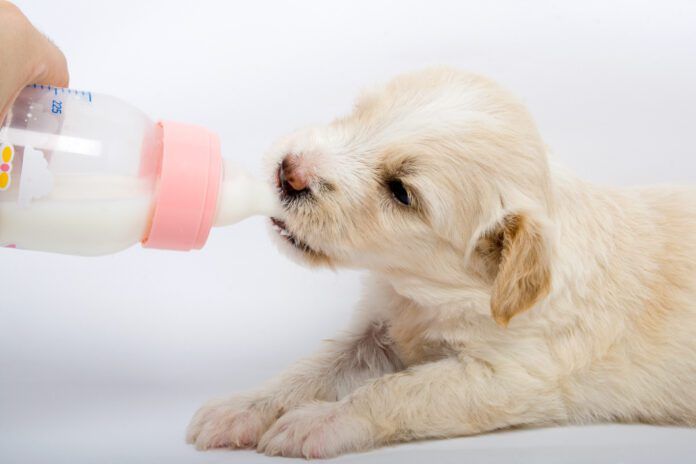
Goat milk has gained popularity among dog owners as a superfood that is a natural source of nutrients and digestive support. It’s true that goat milk contains vitamins, minerals, and probiotics, but is it really a good choice for adult dogs?
To answer that, look at the composition of goat milk, particularly its lactose (natural sugar) content, and how it aligns with a dog’s digestive capabilities, especially considering that dogs, like all adult mammals besides humans, lose the ability to fully digest milk after puppyhood.
To properly digest lactose, the body needs an enzyme called lactase, which breaks it down into useable forms. Puppies produce lactase while nursing, allowing them to digest their mother’s milk efficiently. However, as dogs grow and are weaned off milk, their production of lactase decreases, and they eventually lose the ability to produce it. This means that adult dogs are lactose-intolerant and giving them dairy products can lead to digestive upset, including gas, bloating, and diarrhea.
Goat Milk Can Cause Problems in Dogs
Goat milk is touted as being lower in lactose and more easily digested when compared to cow’s milk. Compared to cow’s milk, goat milk does contain less lactose—on average 4.2% for goat milk compared to 4.8% for cow’s milk. While this is a small difference, it can make goat milk somewhat easier to digest for dogs. Additionally, the fat globules in goat milk are smaller and generally more easily digested during digestion, which may improve tolerance in some dogs.
However, the fact remains that goat milk still contains a significant amount of lactose, especially when compared to dog’s milk, which has only about 2.7% to 3.9% lactose, depending on the breed. This is important because even goat milk, while slightly gentler, is still likely to cause problems in dogs, especially when fed in large amounts or frequently. For adult dogs, whose bodies no longer produce the enzyme necessary to digest milk sugars, lactose-containing milk products can be problematic, regardless of the species they are sourced from.
Reduced Lactose Goat Milk for Dogs
If you are considering adding goat milk to your dog’s diet, do it in moderation and ideally with guidance from a veterinarian. Some owners opt for fermented goat milk, such as kefir, which has reduced lactose content due to the fermentation process and may be better tolerated. Other people look for lactose-free or enzyme-treated milk products specifically designed for canine digestion. These products provide all the benefits owners seek from goat milk without the negative effects of lactose.
While goat milk is sometimes better tolerated by dogs compared to cow’s milk, it is not lactose-free and may cause digestive upset in adult dogs. If you’re looking to support your dog’s gut health or provide extra nutrients, opt for lactose-free goat milk or alternative dietary supplements.
How to Safely Lift and Carry a Dog
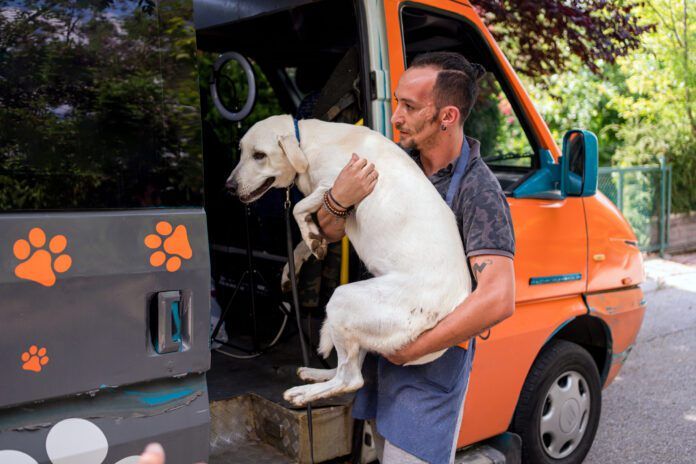
The ability to pick up a large dog requires more than just strength. You need to use the proper technique, understand canine anatomy, and pay careful attention to your large dog’s comfort and safety.
Whether you are helping your dog into a vehicle, lifting them onto a grooming or exam table, or assisting a senior dog up the stairs, knowing how to properly pick up, hold, and carry a large dog can prevent injury for both you can your pet. Mishandling a big dog, even with the best intentions, can cause stress, pain, or worsen underlying conditions, especially in dogs with joint issues, injuries, or mobility concerns.
Before Picking up the Dog
Before attempting to pick up your dog, assess the situation and determine whether it is truly necessary to carry them. Even the nicest dog may lash out if they are afraid or in pain, so picking them up may not be a safe option.
Many big dogs are heavy enough that picking them up should be done only when necessary, such as in emergencies, recovery from surgeries, or when mobility is compromised. If the situation is not urgent and your dog can move on their own with some encouragement or mild assistance, that is always the safer option.
Proper Form Lifting a Heavy Dog
One of the most important aspects of lifting a big dog is maintaining proper body mechanics. Watch this excellent video that shows how to properly pick up a big dog.
Remember, just like lifting heavy objects, picking up a large dog requires using your legs, not your back:
- Stand with your knees shoulder-width apart and bend at the knees, not at the waist, keeping your back straight.
- Move calmly and confidently, as quick, jerky movements can startle a dog.
- Place one hand around the front of your dog’s chest, at the base of their front legs, to support the dog’s weight and keep them stable.
- Place your other arm behind your dog’s back legs to support their back half without placing pressure on their abdomen. This two-arm method distributed the dog’s weight evenly and prevents unnecessary strain. If your dog is too large for this, or if they have arthritic hips or joint pain, placing one arm under their chest behind their front legs with your other arm just in front of their hind legs, under the abdomen, is an alternative.
- With your arms in place and your dog feeling secure, slowly straighten your legs to lift, keeping your dog close to your body to maintain balance. The closer your dog is to your core, the more stable you will be.
Mobility Harnesses
For giant breed dogs or dogs weighing over 100 pounds, lifting your dog manually may not be practical. In these cases, equipment can make all the difference. Mobility harnesses with handles, rear-end slings, or dog stretchers are incredibly useful tools. These devices are designed specifically to support a dog’s body in a safe and ergonomic way, reducing stress on your dog’s spine and joints while also minimizing the effort required on your part. Harnesses with front and rear handles allow for two-person lifts and are particularly helpful for dogs recovering from surgery or those with chronic mobility issues such as arthritis or hip dysplasia.
Knowing how to safely pick up, hold, and carry your dog is part of being prepared for life’s unexpected moments, but if you find yourself needing to lift your dog frequently or if your dog struggles with mobility, consult with your veterinarian to explore some long-term solutions.
MSM for Dogs
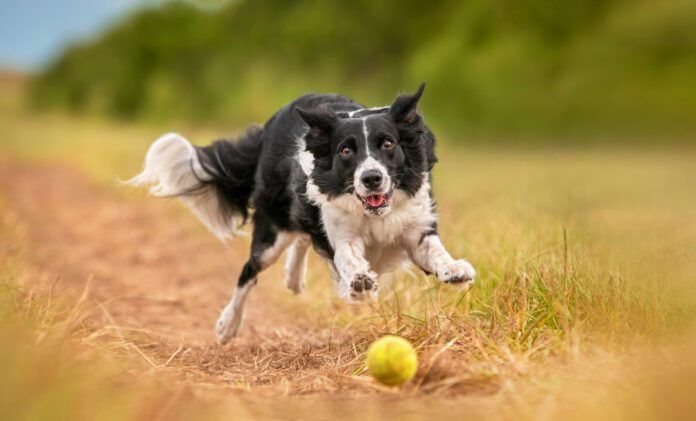
MSM is included in most dog arthritis supplements for good reason. It works and has research backing up its use. MSM is methylsulfonylmethane, a naturally occurring compound made up of sulfur, carbon, and oxygen. Although it can be found in small amounts in certain plant and animal products, it is most commonly produced synthetically for use in dietary supplements. In both human and veterinary supplements, MSM is used for its anti-inflammatory and pain-relieving properties, making it a valuable tool in managing a variety of chronic health conditions, particularly those affecting joints.
MSM to Reduce Dog Joint Inflammation
One of MSM’s most well-known benefits is its ability to reduce inflammation. Chronic inflammation is a main culprit behind the joint pain experienced by dogs suffering from arthritis, degenerative joint disease, or previous injuries. This ongoing inflammatory response not only causes pain but can also contribute to further joint deterioration over time. MSM helps reduce the production of inflammatory compounds, targeting the root of discomfort rather than merely masking the symptoms. This reduction in inflammation can significantly improve your dog’s mobility and overall comfort, especially during activities that were once difficult or painful.
MSM for Pain in Dogs
In addition to its anti-inflammatory properties, MSM has mild analgesic effects, helping to relieve pain. When pain relief is paired with a decrease in inflammation, the result can be a noticeable happier and more active dog. Pet owners often report seeing their dogs become more energetic and willing to engage in activities they had previously avoided. These improvements mark significant step forward in restoring your pet’s quality of life.
What Is MSM?
MSM is a compound rich in organic sulfur, which is essential for many biological processes and necessary for the synthesis of collagen and glucosamine, key components for healthy cartilage and connective tissue. Cartilage acts as a cushion between the bones in joints. As dogs age, this cartilage can break down leading to painful bone-on-bone contact. By supplying the body with the sulfur it needs, MSM supports the rebuilding and maintenance of these tissues. Some studies suggest that MSM may enhance the absorption of other joint-supportive nutrients like glucosamine and chondroitin. This synergistic effect is part of what makes MSM such a popular component in many joint supplement blends.
Which MSM Supplement for My Dog?
MSM supplements are available in a variety of forms including powders, capsules, soft chews, and liquids, making it easy to incorporate into your dog’s daily routine. Whether used on its own or as a part of a multi-ingredient joint care formula, MSM is a natural compound with the potential to offer meaningful and lasting relief for your pet.
When purchasing supplements, look for the NASC seal. That’s indication that the manufacturer is a member of the National Animal Supplement Council. Member manufacturers voluntarily submit their products for testing and approval, which indicates to the consumer that the products contain the ingredients listed on the label and the sources of those ingredients are NASC-approved.
Note: The only exception to this is products from Nutramax. This company was one of the original manufacturers of supplements for animals. They were a leader in producing groundbreaking research on ingredients, dosages, and quality control for animal supplements. They remain an undisputed giant in quality control and research.
You can purchase MSM for dogs without any other ingredients. WDJ top choices are:
- NaturVet MSM
- PeakTails MSM
- VitaFlex MSM
That said, we prefer to use MSM as a strong ingredient to include in multi-ingredient joint products. Look for glucosamine, chondroitin, green-lipped mussel, and MSM. The WDJ top five joint supplements that include MSM in the mix are:
- Nutramax Cosequin
- Nutramax Dasuquin
- Zesty Paws Hip and Joint Bites
- The Missing Link Hip and Joint Powder
- VetriScience Healthy Hip and Joint
Note: It is important to note that, while this article focuses on MSM, fish oil shouldn’t be overlooked as a strong supplement to support joint health.
For many dogs, especially those experiencing age-related joint degeneration or pets recovering from orthopedic injuries or procedures, MSM can play a significant role in improving mobility, easing pain, and supporting long-term joint health. Always consult your veterinarian before beginning any new supplement, but if joint pain is impacting your dog’s quality of life, MSM is certainly worth considering as a part of a wholistic approach to your dog’s care.
Don’t Adopt Littermates
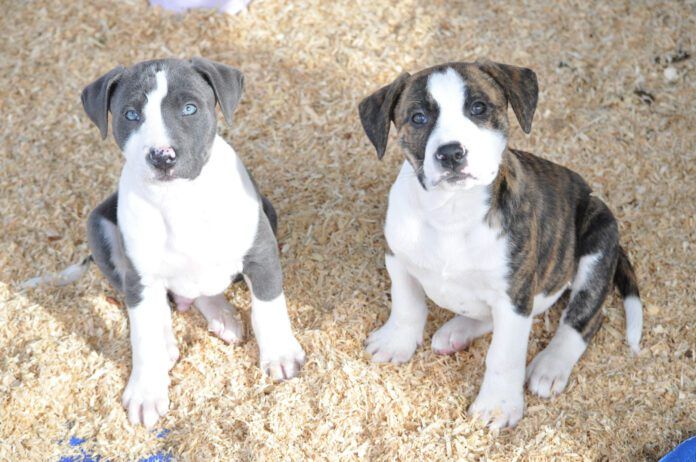
You’ve gone to the shelter, excited about the photos they posted on social media of a big litter of pups that look like just the kind you’ve been waiting for. It’s near closing time—you couldn’t get there until after you got off work!—and the shelter staff is clearly buttoning things up for the night. It turns out that the litter was popular; there are just two puppies left from which to choose! As you approach their pen, you see that the littermates are entwined in a small single dog bed. They blink at you sleepily, and then approach the front of the kennel to greet you, almost as one—and the thought of taking one home, leaving the other completely alone in the cold concrete shelter kennel, brings tears to your eyes. They are clearly so bonded! How much harder could it be to raise two dogs, you think to yourself? If we adopt both, they can keep each other company at home!
STOP! Don’t do it! Whether the idea of adopting two puppies just occurred to you, or you had been planning to adopt two all along, every trainer I’ve ever met would advise you to think twice and adopt just one. Because training and socializing littermates well is more than twice as difficult as training and socializing one puppy.
There have been littermates in several of the group puppy classes I’ve taught recently, and in every case, the family who adopted them looks overwhelmed and sounds regretful about the decision they made to adopt two. It’s noteworthy, also, that each family has told me that if they knew then what they know now, they would not have adopted two. They love their dogs, they are working hard to make it work, but they had no idea that certain things would be so difficult. Things like:
- One pup is anxious and a little reactive, which the other is generally very calm and takes new things in stride. But when the anxious dog barks and growls at new sights and situations, it makes the other pup bark and grow suspicious also—and increasingly, both dogs bark when they see new people or something unfamiliar!
- You are crossing the living room when you realize your sock is wet. You discover a series of wet, urine-soaked spots on the carpet. Which pup is having trouble with house training?
- You find some vomit in the puppy pen. Which one isn’t feeling well? Which one may have swallowed a sock and potentially needs to be taken to the vet?
- You’re trying to train both puppies the basics: sit, down, stay, etc. Except one puppy leans fast and dives for all the treats, and the other is disinterested in competing . . . So, as time goes by, one pup knows a few things, and the other hasn’t really learned anything at all.
- One pup had to go to the vet and you’ve discovered that the other is petrified to go outside without his brother. You thought that this pup was just a little less confident without the other, but it turns out that without his guide, he’s terrified of everything!
- Or, one dog had to go to the vet—and that’s when both dogs starting howling, panicking in their crates, tearing at the crate doors with their paws, vomiting—in an utter panic at being without their littermate. Who knew they were that bonded?
If that last scenario doesn’t give you the shivers, consider this: What if some disaster befell your family, and you had to rehome the dogs? It’s hard enough to find a good home for one adult dog; who will possibly take on two dogs who can’t be separated?
Don’t just take it from me: Here are two articles from the WDJ archives written by professional trainers who have seen it for themselves:
“Are Two Pups Better Than One?”
“Problems with Adopting Two Puppies Simultaenously”
Does My Dog Need Electrolytes?
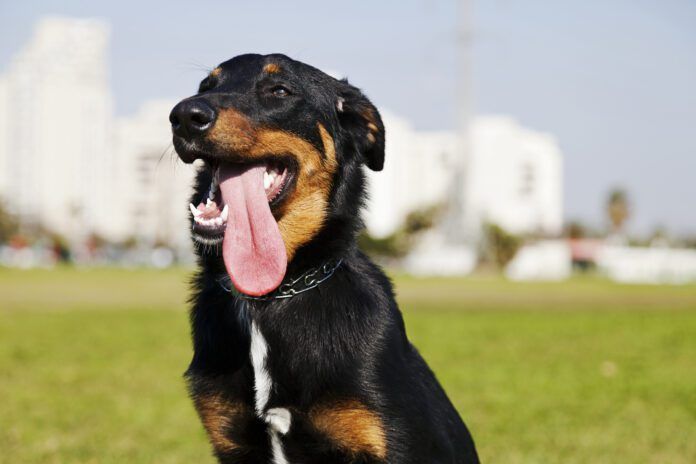
While electrolytes are essential for proper bodily function, most healthy dogs do not require electrolyte supplementation unless they are experiencing significant fluid loss through vomiting or diarrhea.
Humans and dogs have different needs for hydration and electrolyte balance. Most healthy dogs do not require added electrolytes in their diet under normal circumstances. Understanding how dogs regulate their hydration and when electrolyte supplementation is truly needed can help you make informed decisions, especially during times of illness or extreme exertion.
Electrolyte Loss Through Dog Panting
Unlike humans, dogs do not sweat to regulate their body temperature. Instead, they pant. Humans lose a significant amount of electrolytes, including sodium, chloride, potassium, magnesium, and calcium, which is why replenishing them after strenuous exercise or heat exposure is so important for people. Dogs, on the other hand, lose minimal electrolytes through panting, which relies on evaporative cooling of saliva. As a result, giving electrolytes to dogs simply because they are active or because it is a hot day is generally unnecessary and can even lead to electrolyte imbalances if not used correctly. Avoid giving your dog “electrolyte water” or other homemade electrolytes. It’s just not worth the risk.
When Your Dog Needs Electrolytes
The situations where your dog may need electrolyte supplementation are specific. The most common scenarios include vomiting, diarrhea, or severe dehydration caused by illness or heat stroke. In these cases, dogs may lose a significant amount of fluids and electrolytes like sodium, potassium, and chloride, which can disrupt normal cellular function and overall hydration status.
For dogs experiencing these kinds of losses, veterinary-formulated electrolyte fluids, often administered subcutaneously, can help restore balance and support recovery. It is important, however, that any supplementation be done under veterinary guidance, especially for dogs with underlying medical conditions or for those on medications.
The Pedialyte Question for Dogs
Pedialyte, a popular electrolyte drink designed for humans, can sometimes be given to dogs in specific situations, but it should be used with care and fresh water should also be offered. If a dog is experiencing mild dehydration due to vomiting, diarrhea, or heat-related stress, Pedialyte may help replenish lost fluids and electrolytes. However, it is important to choose the unflavored and unsweetened version, as flavored varieties often contain artificial sweeteners such as xylitol, which is toxic to dogs, or added sugars that can upset their stomach further. Even the unflavored type should be offered in small amounts and, ideally, under the guidance of a veterinarian. Pedialyte is not a cure for the underlying cause of dehydration, so if your dog is lethargic, refuses to drink, or shows signs of worsening illness, professional veterinary care is crucial.
Betaine for Canine Hydration
An emerging area of interest in canine hydration is the use of functional ingredients like betaine, a naturally occurring compound found in foods like beets. Betaine acts as an osmolyte, which means it helps cells maintain fluid balance without disrupting normal cellular processes. In simple terms, it helps cells hold on to water more effectively, especially during times of heat or stress.
Unlike electrolyte supplementation, which addresses losses after the fact, betaine works by helping the body maintain hydration in the first place. This makes it particularly useful in scenarios where hydration is a concern, but electrolyte loss is not significant, such as for working or athletic dogs that may be under physical stress but not actively losing fluids through vomiting or diarrhea. By using products like betaine, you can optimize hydration status without unnecessarily loading the body with salts it does not need.
Remember, most dogs only require electrolytes when they are sick with vomiting and/or diarrhea. If your dog is sick, call your veterinarian to ask about electrolyte supplementation and work with the vet to create a plan of care for your pet.
Is the Pavement Too Hot to Walk My Dog?
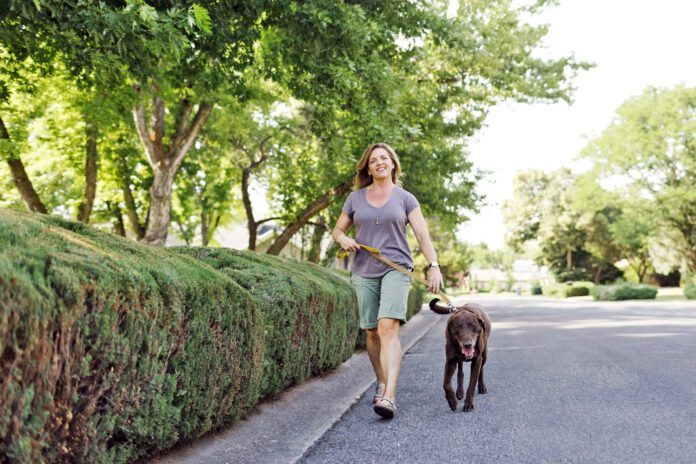
Dog walks are the highlight of the day for most dogs. But what about when it’s hot and humid, with the sun beating down on that black asphalt? How do you know if it’s safe to walk your pup then?
Learn to identify the temperature of the area where you want/need to walk. Many experts recommend the “7-second rule.” Place your hand on the pavement/asphalt/surface for 7 seconds. If it’s too hot for you at that time frame or before you even reach 7 seconds, it’s too hot for your dog without protection.
When is it Too Hot for Dogs?
While we find the 7-second rule to be the simplest, if you prefer, you can also use a digital infrared thermometer or consult the chart from the Extension at University of Georgia (reproduced below) that lists air temperature and how it affects grass temperature, asphalt temperature, and more.
Pavement Temperature Chart for Dogs
| Time | Grass in Shade | Grass in Sun | Air Temp | Cement | Red Brick | Black Top |
|---|---|---|---|---|---|---|
| 7 AM | 70°F - 21°C | 74°F - 23°C | 76°F - 24°C | 78°F - 26°C | 78°F - 26°C | 80°F - 27°C |
| 8 AM | 72°F - 22°C | 77°F - 25°C | 77°F - 25°C | 80°F - 27°C | 81°F - 27°C | 81°F - 27°C |
| 9 AM | 78°F - 26°C | 85°F - 29°C | 88°F - 31°C | 93°F - 34°C | 95°F - 35°C | 89°F - 32°C |
| 10 AM | 82°F - 28°C | 86°F - 30°C | 90°F - 32°C | 99°F - 37°C | 105°F - 40°C | 103°F - 39°C |
| 11 AM | 85°F - 29°C | 98°F - 37°C | 92°F - 33°C | 105°F - 41°C | 115°F - 46°C | 125°F - 52°C |
| 12 PM | 88°F - 31°C | 100°F - 38°C | 93°F - 34°C | 112°F - 44°C | 125°F - 52°C | 130°F - 54°C |
| 1 PM | 90°F - 32°C | 103°F - 39°C | 94°F - 34°C | 115°F - 46°C | 130°F - 54°C | 135°F - 57°C |
| 2 PM | 91°F - 33°C | 105°F -41°C | 95°F - 35°C | 125°F - 52°C | 135°F - 57°C | 140°F - 60°C |
| 3 PM | 91°F - 33°C | 105°F - 41°C | 95°F - 35°C | 124°F - 51°C | 134°F - 57°C | 140°F - 60°C |
| 4 PM | 89°F - 32°C | 102°F - 38°C | 95°F - 35°C | 118°F - 48°C | 131°F - 55°C | 137°F - 58°C |
| 5 PM | 87°F - 31°C | 98°F - 37°C | 93°F - 34°C | 112°F - 44°C | 122°F - 50°C | 131°F - 55°C |
| 6 PM | 85°F - 29°C | 96°F - 35°C | 91°F - 33°C | 106°F - 41°C | 110°F - 43°C | 122°F - 50°C |
| 7 PM | 83°F - 28°C | 86°F - 30°C | 90°F - 32°C | 100°F - 38°C | 105°F - 41°C | 112°F - 44°C |
| 8 PM | 80°F - 27°C | 80°F - 27°C | 87°F - 31°C | 95°F - 35°C | 98°F - 37°C | 103°F - 39°C |
| 9 PM | 78°F - 26°C | 78°F -25°C | 84°F - 29°C | 90°F - 32°C | 92°F - 33°C | 93°F - 34°C |
For example, according to the chart, at 2 p.m., on a 91-degree day, the asphalt is 140 degrees. That’s too hot for your dog’s paws. This is your most basic and simplest dog walking temperature chart.
With the information at hand, you can best determine if surfaces like blacktop are too hot for your bare paw dog to walk over.
Summer Dog Walks Are Critical
Walks are important mental enrichment for dogs. It would be a sad thing for dogs to miss them simply because it’s hot outside. Learning how to do this safely is of utmost importance to both the dogs and humans in their lives.
Dog walks don’t always have to be high activity. They just need to be fun for your dog! If you can drive your dogs to a wooded area that offers an abundance of shade and sniffing opportunities, do this.
Bring plenty of water and a bowl for your dog to drink from. Walk slowly and simply allow sniffing and pottying without a goal of getting somewhere. Be mindful of how far away from your vehicle you are walking and allow for the energy needed to get back there safely.
If possible, aim for dirt/grass/mossy terrain versus asphalt and concrete. Know your dog’s limits and breathing abilities and consider their age/overall health/physical fitness levels as well as their color. Dark dogs get hotter faster as do floofy dogs. Double that for a dark floofy dog. Brachycephalic dogs do have breathing handicaps that are even worse when it’s hot.
Schedule Your Dog Walks to Avoid Heat
If you must walk in your own neighborhood that consists of primarily concrete or asphalt surfaces, do the longer walks early in the morning or later at night when it’s a bit cooler.
Make additional potty breaks short and purposeful. Invest in a paw protectant like Musher’s Secret, a highly recommended choice. This not only protects paw pads from ice/cold/salt in the winter, but it also protects from heat in the summer. Booties are also an option if your dog will wear them, but most dogs prefer the balm.
Take fresh water and go slowly and stick to grass when you can. The same rules as above apply. Keep it short with the goal of sniffing and pottying.
Provide extra indoor mental enrichment to make up for shorter walks. Examples can include snuffle mats, lick mats, puzzle toys, search games, and training time.
Tips to Make Hot-Day Dog Walks Safer
- When it’s hot, do not take lengthy walks or runs. It doesn’t matter whether you can handle this heat, your dog cannot.
- Take extra care with brachycephalic breeds like Pugs and Frenchies. These dogs cannot breathe normally. Don’t place them in danger.
- Never leave dogs in your yard unattended in overly warm temperatures for longer than a very short time. Make sure that there is adequate shade available as well as fresh water and even a doggy pool if your dog enjoys such.
- Check on them frequently, meaning every few minutes in some cases. It doesn’t take long for a heat-related issue to surface.
- And, of course, never leave your dog in a vehicle in hot and humid temperatures for even a literal minute, even with AC on. In high-humidity temperatures, the AC and the car will be less reliable.
How to Get Mats Out of Dog Hair
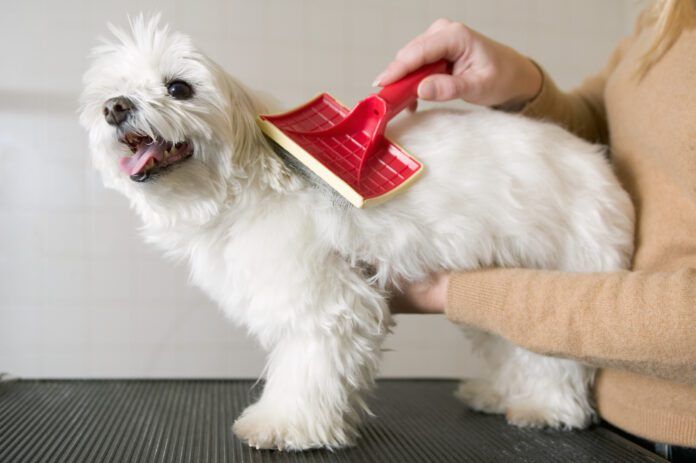
An abundance of grooming tools flood the market for dogs who battle hair mats. I urge you to do your due diligence if you prefer to handle much of your dog’s grooming yourself. All tools are not right for all dogs, making research and listening to user reviews very important. Also important, as you will see here, is keeping up with mats and grooming.
I have an Ovcharka (also known as a Caucasian Shepherd Dog) and a Chow Chow. These dogs are about as floofy as it gets. The same rake that I used with my previous Ovcharka is the one that I prefer with my current Ovcharka. Oddly though, the super expensive Chris Christenson slicker brush that was gifted to me for my previous cream Chow Chow does not work well for my current red Chow Chow.
My cream Chow Chow had cotton-candy texture fur that was thick but fine. That brush worked great with her almost delicate coat. My red Chow Chow has a very thick coarser coat that is better dealt with by the same rake that I use with my Ovcharkas. Dog coats can be very different, even within breeds.
Removing Mats From Dog Hair
Mats are painful for dogs and can irritate and pull their skin if left in. I prefer to finger-comb mats out when they are just starting, especially in the floofy parts and the back of the legs. Neck mats can often be minimized by simply keeping up with the rake several times a week to remove the excess.
A light touch is important to a low-stress grooming experience. If a mat is too difficult to remove easily without stressing the dog, I cut them out with my hair cutting scissors (place a human comb between the dog’s skin and the scissors to avoid cutting the dog’s skin when removing a mat with scissors). Of course, try to trim evenly. They don’t care if they look snappy, but their mom does!
Rakes: I use primarily rakes with my dogs. For shorter-haired dogs, Furminators work fine, but they seem to cause too much pulling in my longer-coated dogs. An undercoat rake removes fur more deeply but needs a light touch to not rip out fur harshly.
Slicker brushes: Among the long-haired-dog parents I polled on this subject, slicker brushes were favorites.
Deshedding blades: These tools can work with thicker coats. The Zoom Groom is a favorite for silker coated smaller dogs.
Dematting combs: A trusted colleague of mine recommends the Raw Paws dematting comb for her dogs. A regular dog comb can work just fine as well.
Clippers: There are no best dog clippers for removing mats. Leave that tool to the professionals.
Preventing Mats in Dogs
Remembering to demat regularly—at least once or twice weekly—and brush around the ears and tails, preferably daily. This can go a long way toward preventing mats. Remember that mats can form wherever there is hair, including on the inside of back legs or in the elbow area. There are spray detanglers for after baths, but nothing beats proper grooming maintenance.
Mats can become painful, especially when they get large, so use patience when removing the mat. It’s important to minimize potential stress on your dog. And keep up with regular grooming, there’s no better mat prevention technique.
Adequan for Dogs
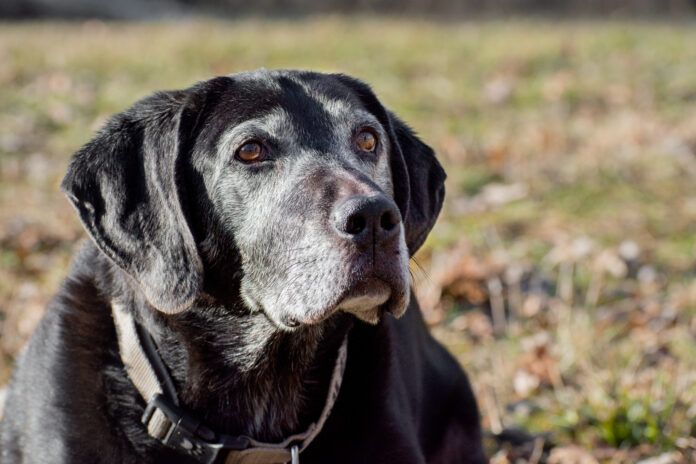
Adequan is an injectable medication for the treatment of osteoarthritis in dogs. It is a disease-modifying osteoarthritis drug (DMOAD), meaning it can reverse some of the damage that occurs in arthritic joints.
Adequan contains polysulfated glycosaminoglycan (PSGAG), which has been shown to inhibit catabolic enzymes that contribute to the destruction of cartilage in arthritic joints. PSGAG has also been shown to stimulate the production of anabolic enzymes. Anabolic enzymes promote cartilage repair and enhance the quality of synovial fluid in arthritic joints.
So, what exactly does this mean for dogs suffering from osteoarthritis? Let’s take a look at the basic structure of joints to get a better understanding of how Adequan works.
Understanding Canine Joint Structure and Osteoarthritis
A joint is the junction of two or more bones that allows movement, such as the back-and-forth movement of the knee. The ends of the bones are capped with a smooth, glistening substance called cartilage. Think about the last time you ate a chicken wing (or watched someone else eat a chicken wing, if you don’t eat meat). That smooth white cap on the end of the chicken wing bone is cartilage.
Cartilage protects the ends of the bones from damage and provides a smooth surface for movement of the joint. The ends of the bones are connected by ligaments—strong, fibrous bands of tissue that keep the joint aligned and prevent it from moving in inappropriate ways.
The joint is surrounded by an envelope of fibrous tissue called a joint capsule. The joint capsule creates a sealed space around the joint which is filled with synovial fluid. Synovial fluid is produced by cells that line the inside of the joint capsule. It is viscous (thick) so that it can provide shock absorption within the joint and lubricates the joint to keep everything moving smoothly.
Cartilage requires nutrition and oxygen to perform its functions. Blood is the primary source of oxygen and nutrients in the body. Cartilage does not contain any blood vessels and therefore has no direct source of nutrition and oxygen. It can obtain some of these vital ingredients from blood vessels in the ends of the bones the cartilage covers. However, most of its nutritional needs are met by absorbing oxygen and nutrients from synovial fluid within the joint.
Joints affected by osteoarthritis experience inflammation and degradation of cartilage. Inflamed cartilage releases catabolic enzymes which cause further degradation of the damaged cartilage. This turns into a vicious cycle of inflammation and degradation that makes cartilage thin and brittle.
Bones that are capped by thin and brittle cartilage do not have the same protection as those covered by thick, healthy cartilage. Bones that do not have adequate protection within joints become damaged and painful. Adequan slows the progression of osteoarthritis and improves joint health.
How Adequan Works
Adequan inhibits the production of catabolic enzymes in inflamed joint cartilage. Catabolic enzymes destroy molecules that are necessary for maintaining healthy joints. These molecules include:
- Proteoglycan—an important building block of cartilage.
- Collagen—this structural protein is the basis for cartilage, ligaments, and tendons.
- Hyaluronic acid—a lubricant in synovial fluid.
Adequan also enhances the activity of anabolic enzymes inside joints. Anabolic enzymes stimulate production of collagen, proteoglycans, and hyaluronic acid. These are necessary to repair damaged cartilage and keep synovial fluid happy and healthy. Adequan has also been shown to reduce inflammation in arthritic joints.
Treating a Dog with Adequan
Adequan can be an effective part of a multi-modal therapeutic plan for the treatment of osteoarthritis in dogs. It is administered by intramuscular injection and, once injected, it moves from the muscle into the bloodstream. Then it passes from the bloodstream into each joint’s synovial fluid. Joint cartilage absorbs Adequan from the synovial fluid.
Adequan is given twice a week for four weeks for a total of eight doses. Peak concentration of Adequan in the bloodstream is achieved about 20 to 40 minutes following intramuscular injection. It takes about two days for Adequan to reach peak concentration in synovial fluid. Adequan persists at peak concentration in the joints for an additional three days.
The concentration of Adequan in synovial fluid and cartilage will be higher than that found in the bloodstream once the series of injections has been completed. Cartilage damaged by osteoarthritis will take up more Adequan than joints unaffected by osteoarthritis.
Adequan is only indicated for the treatment of non-infectious arthritis and degenerative joint disease. It is not for use in dogs with septic or infectious arthritis.
Side Effects of Adequan
The most common side effect of Adequan is pain at the injection site. Other side effects are transient and include vomiting, diarrhea, and decreased appetite. These side effects typically resolve quickly and without intervention.
Adequan shares structural similarities with a compound called heparin. Heparin is an anticoagulant that is used to prevent formation of clots in the bloodstream. Abnormal bleeding in the first 12 hours after administration of Adequan is rare but has been reported. Adequan should be used with caution in dogs that have a bleeding disorder.
Adequan for Dogs: Cost and Dosage
Adequan is purchased by the vial and is dosed by a dog’s weight. Bigger dogs require a larger Adequan dose than smaller dogs. Therefore, it costs more to treat a bigger dog with Adequan.
Adequan is the only FDA-approved DMOAD available in the United States. Cartrophen is a DMOAD that is available in other parts of the world, including Canada, Australia, and Europe. Do not confuse Cartrophen with the non-steroidal anti-inflammatory drug (NSAID) called carprofen (also known by the brand name Rimadyl).
Best Dog Water Bottles for Hikes
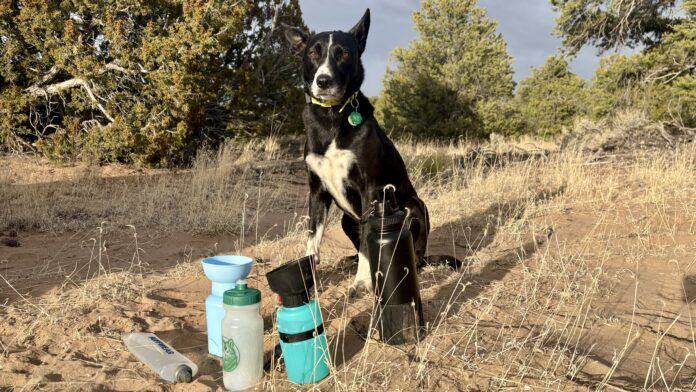
You need to stay hydrated while hiking, and so does your dog! Giving your dog plenty of water while hitting the trails will ensure they stay cool and avoid heatstroke, especially in the hot summer months. That’s where portable dog water bottles come in. A dedicated dog water bottle will make it easy to carry your pup’s water and make it easier to offer them a drink more frequently.
We tested six different dog water bottles, including ones that had collapsible bowls attached, soft-sided bottles that your dog can carry in a dog hiking backpack, and options with fun features like a detachable treat compartment. Read on for our top picks:
Traits We Want In a Dog Water Bottle for Hiking
Portability: The best dog water bottles for hiking should be portable enough to throw in a hiking backpack (or even a belt bag/treat pouch), but big enough to carry an adequate amount of water. The typical rule of thumb is to carry eight ounces of water per dog for every hour spent hiking. For one dog, a 16-ounce water bottle is a good starting point if you’re planning on hiking for 1-2 hours.
It’s nice to have a carabiner clip on a dog water bottle as well, so you can easily clip it to a hiking backpack while adventuring with your pup.
Leak-proof design: If you’re going to carry your dog water bottle in a backpack or fanny pack, a leak proof design is paramount. We tested all the bottles on this list for leak-proofness and noted any that were prone to spilling.
Extra features: Extra features like an attached bowl are helpful if you don’t want to carry a separate travel bowl. Water bottles with attached bowls also typically suck up any unused water back into the bottle, so you don’t waste any
Easy cleaning: If easy cleaning is a must, opt for a dog water bottle that can be cleaned in the dishwasher. This will likely limit you to hard-sided bottles, as the ultra-portable soft-sided options are usually hand wash only.
The Best Dog Water Bottles for Hikes
| WDJ Paw Rating | Product, Maker, and Website | Prices | Size | Notes |
|---|---|---|---|---|
   | Springer Pets Flip Dog Travel Bottle | $28 | 20 ounces | Our best overall pick, the Springer Pets Flip Dog bottle comes with an attached bowl, is leak-proof, and has a handy carabiner clip. |
   | LESOTC Outdoor Dog Water Bottle Dispenser | $13 | 21 ounces | This squeeze-style bottle has an attached silicone bowl and a handy lock on the outside of the bowl. However, it didn’t always drain fully during testing. |
   | Ruffwear 1L Collapsible Water Bottle | $10 | One liter | For backpacking or longer day hikes, this soft-sided bottle from Ruffwear is a good option. It carries a full liter of water, and even fits into dog hiking backpacks, so your dog can carry their own water. |
   | Ruffwear Trail Runner Soft Flask | $15 | about 12 ounces | For short hikes or park walks, this lightweight bottle is super packable and even fits in most fanny pack style dog treat pouches. Just remember to bring a separate collapsible dog bowl. |
   | Frisco Water Bottle with Treat Food Container | $20 | 24-ounce bottle, 8-ounce treat compartment, 13-ounce silicone cup | Though it’s a bit too bulky for hiking, this insulated bottle is a great pick for car travel and includes a separate treat compartment and a silicone bowl. |
   | Wilderdog Plant Based Water Bottle | $14 | About 20 ounces | This classic sport cap bottle is made of corn (not plastic!) and fits well in most water bottle compartments on bags and on bikes. |
Best Dog Water Bottle for Hiking: Springer Pets Flip Dog Travel Bottle
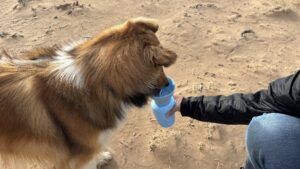
The Springer Pets Flip Dog Travel Bottle is compact, lightweight, has travel-focused features, and comes in a bunch of cute, muted colors.
My Collie loved drinking out of this bottle. Multiple times while hiking, I offered her a bowl of water or a drink out of the Flip Dog Bottle, and every time, she chose the Flip Dog bottle. I think she even drank out of this bottle when she wasn’t thirsty, just because she liked it that much.
This squeeze bottle has a silicone bowl attached to the top that flips up for use and down for travel. When you squeeze the bottle, the bowl fills with water, then you can hold it in front of your dog to drink. Once they’re done, any leftover water drains back into the bottle when you stop squeezing it. If you don’t want to keep squeezing the bottle as your dog drinks, you can also lock it, so the water doesn’t suck back down into the bottle. The lock also means water can’t squeeze out of the bottle by itself when not in use. In addition, the bottle comes with a convenient carabiner clip that’s easy to clip onto backpacks, bags, or dog treat pouches.
This bottle is easy to use and didn’t leak at all during testing, even when I took it with me on a weekend trip and tossed it in multiple bags over three days. My only qualm with it is that if you want to lock the amount of water in the bowl, you have to stick your fingers into the water to turn the lock. I’d much prefer it if the lock was outside of the bowl, but my dogs didn’t mind drinking while I held the bottle, so I rarely had to use this feature.
If your dog is shy about drinking, skip the squeeze-style water bottles and opt for a normal travel bottle and a collapsible bowl so they can have a little extra space while they sip.
Best Budget Dog Water Bottle for Hiking: LESOTC Outdoor Dog Water Bottle Dispenser
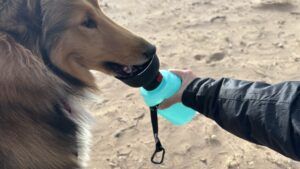
If you’re not sure if your dog will drink out of a handheld water bottle with a bowl attached and you don’t want to invest as much money, the LESOTC Outdoor Dog Water Bottle is worth a look. It’s often priced between $12 and $14 on sale, so trying it out won’t cost much.
This bottle is a squeeze style with an attached, flippable bowl, similar to the Springer Pets Flip bottle. I liked the locking mechanism on this LESOTC bottle better than the Springer Pets one, simply because it’s completely outside the bowl, so you don’t have to stick your fingers in the water to lock it.
However, this bottle was kept out of the winning spot because the water didn’t always drain back into the bottle if my dog didn’t drink all of it. That left me having to dump out a little bit of water occasionally, somewhat defeating the purpose of the squeeze design. With that being said, this bottle is reasonably priced, has a nice big silicone bowl attached to the top, and is easy to squeeze, so folks on a budget should consider it if they don’t mind having to dump a sip or two of water out when their dog is done drinking.
Best Dog Water Bottle for Backpacking: Ruffwear 1L Collapsible Water Bottle
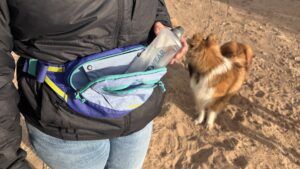
If you’re planning an overnight backpacking trip (or a long day hike) with your dog, the Ruffwear 1L Collapsible Water Bottle is a good pick. The larger capacity ensures you have enough water for multiple hours of hiking and the design fits perfectly in a dog backpacking pack.
I use this water bottle for my dogs with the Ruffwear Approach Dog Backpack, and it fits perfectly in a side pouch. The soft-sided design is super portable and doesn’t add much weight or bulk. When it’s empty, it’s even more portable, and can be rolled up to save space.
This bottle does require carrying an additional travel bowl, or else you risk wasting a lot of water by letting your dog drink directly from the stream. It’s nice to use on day hikes though, since you and your dog can both use the same water (bottles with included bowls suck up your dog’s backwash after they’re done drinking—not great for sharing).
Like human water reservoirs, the Ruffwear 1L Collapsible Water Bottle can only be hand washed and needs a little bit of extra care to dry fully before storing it. Ruffwear recommends using chopsticks to hold it up while drying, then inflating it and putting it upside down to get any excess water out after washing.
Most Portable Dog Water Bottle: Ruffwear Trail Runner Soft Flask
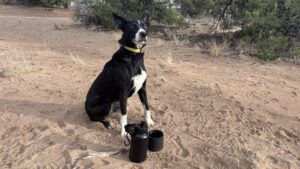
Frequent runners and hikers know about Hydrapak bottles, so they’ll be thrilled to hear that the Ruffwear Trail Runner Soft Flask is the result of a partnership with the hydration brand. The soft-sided design is super portable, and while it’s meant to fit in running belt pockets for running with your dog, it also fits in fanny-pack style treat pouches, making it a great option to bring along for walks where you don’t want to carry a backpack.
At a little over 12 ounces, this bottle is best suited for short runs, walks, and hikes. Anything longer will likely require you bring more water for your dog. I use this bottle for park walks since it’s so packable—but I always have to remember to bring an extra travel bowl with me for my dogs to drink out of.
Similar to the other soft-sided bottle on this list, the Ruffwear Soft Flask can’t be put in the dishwasher. You’ll need to hand wash it, stand it up to dry, and inflate it to get rid of any lingering moisture before storing it.
Best Dog Travel Water Bottle: Frisco Water Bottle with Treat Food Container
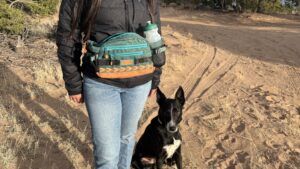
For frequent car rides or longer travel, the Frisco Water Bottle does it all. It features a 24-ounce water bottle, an 8-ounce treat compartment, and a 13-ounce silicone cup that acts as a water bowl.
This bottle is primarily metal and is similar in weight to a Hydroflask or other human metal water bottle. For this reason, I found it too heavy for hiking in most cases. It has a carabiner on the back of it to hook onto a backpack, but during testing, the weight caused my hiking pack to sag more than I liked. It’s also a little bit too inconvenient to unscrew the bottom treat container and grab snacks for your dog while walking.
Instead, this bottle is a good pick for folks who go on longer car rides with their dogs. Whether you go on frequent cross-country road trips or drive multiple hours to find a good dog-friendly camping or hiking spot, this bottle is a great car companion. The silicone cup attachment acts as a separate bowl for dogs who don’t like drinking out of a handheld bottle and the treat compartment is great for refilling an empty treat pouch before you hit the trails.
The water section of this bottle is insulated, so you can fill it with cold or ice water and it’ll actually stay cold in the summer heat. I traveled with this bottle in a bag in the back of my car on a weekend road trip and it didn’t leak at all. It’s also dishwasher-safe for easy cleaning.
Best Eco-Friendly Dog Water Bottle: Wilderdog Plant Based Water Bottle
The hard-sided, eco-friendly Wilderdog Plant Based Water Bottle is made out of corn and is a good size for most water bottle pouches on backpacks. It also fits most bike bottle cages and running belt bottle compartments, so if you regularly bike, bikejor, or do canicross with your dog, this is a good option. The rigid design makes it much better suited for bottle compartments than its soft-sided counterparts.
I’m a big fan of the Wilderdog Mega Hip Pack for hiking, and this bottle fits perfectly in the side water bottle pouches of the pack. The bottle itself is super lightweight, so I’d be okay with carrying two at a time for longer hikes.
The downside of this bottle is that, aside from being made of eco-friendly material, it’s not much different than a typical water bottle with a sport cap. If the corn material isn’t a draw for you, I’m sure you can find a similarly sized water bottle made for humans to use for your dog.


